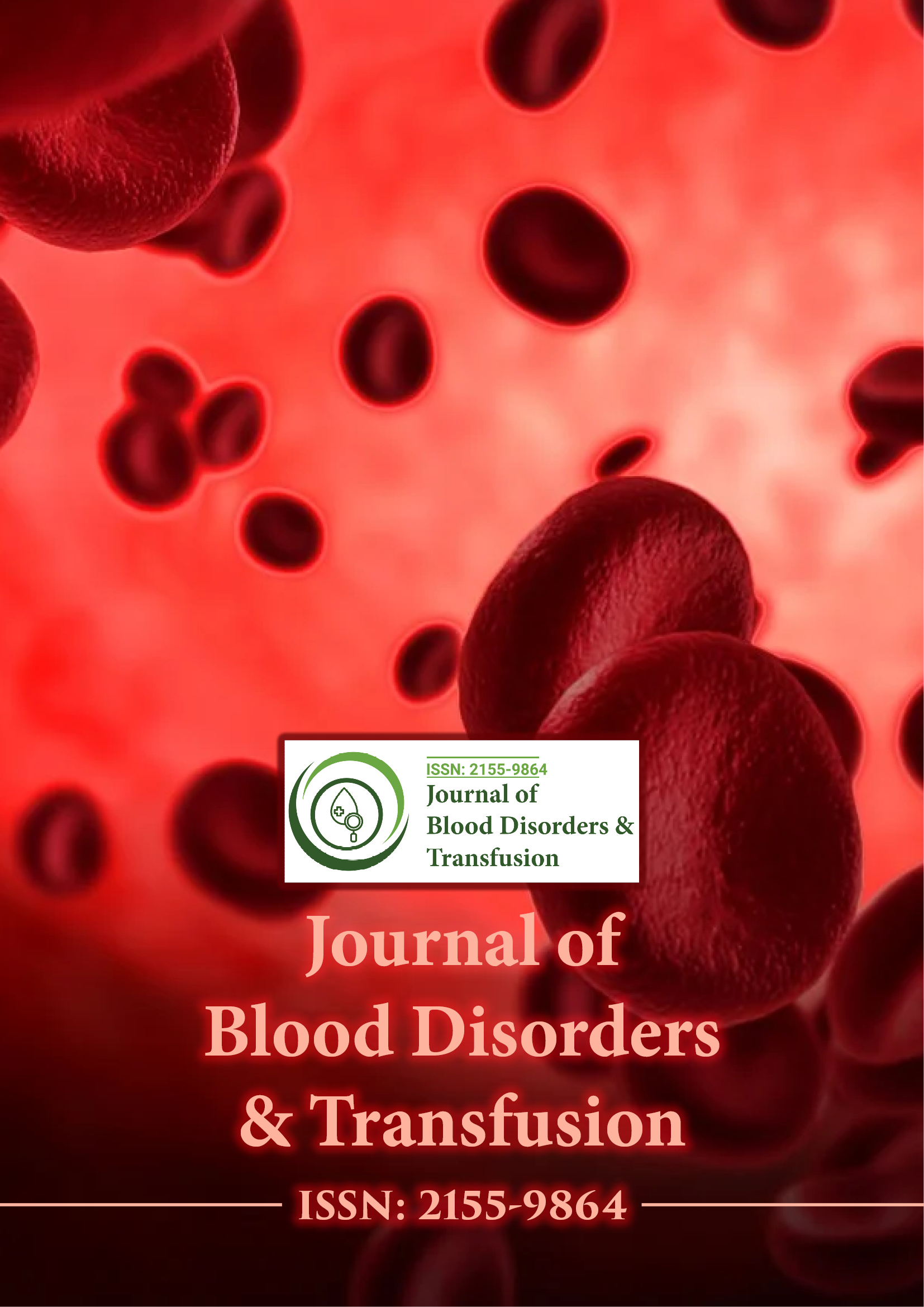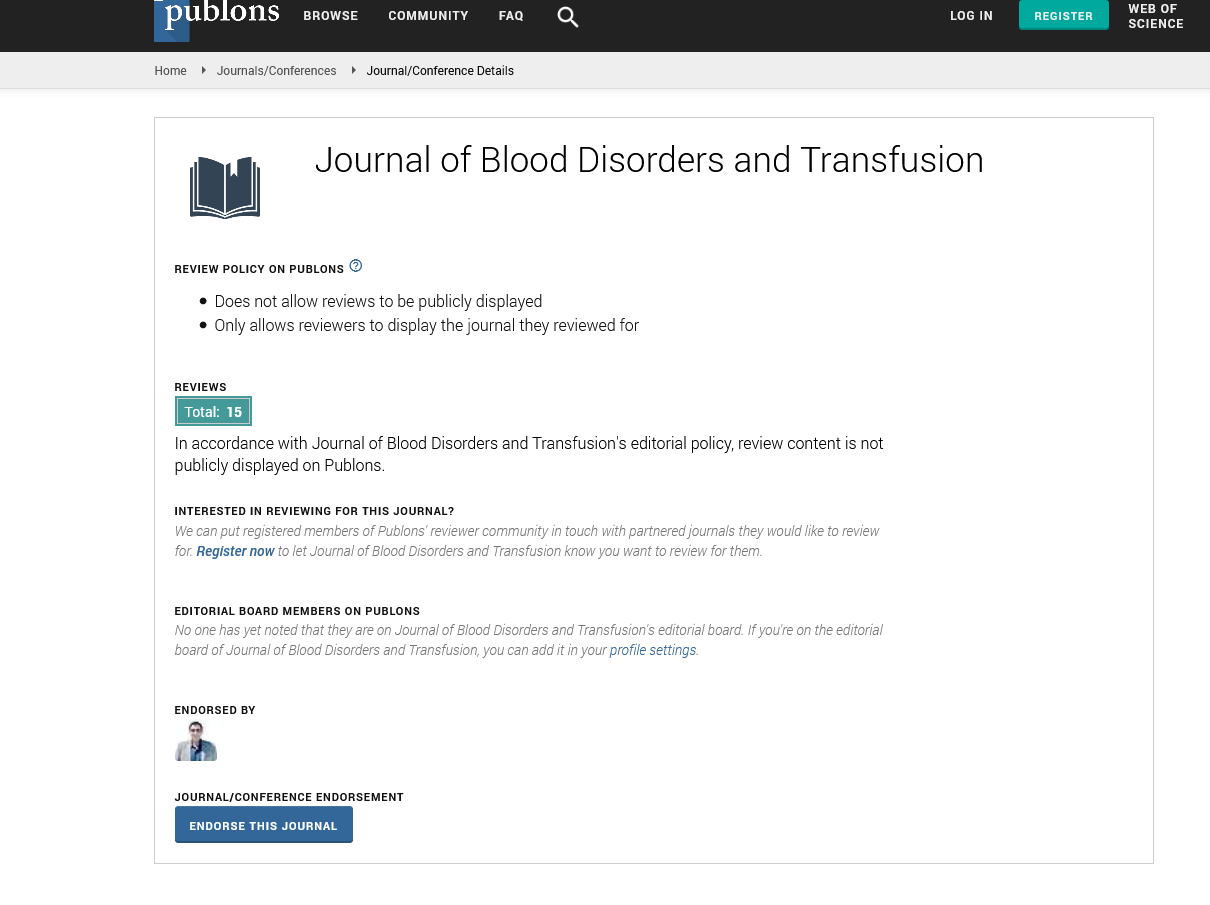Indexed In
- Open J Gate
- Genamics JournalSeek
- JournalTOCs
- Ulrich's Periodicals Directory
- RefSeek
- Hamdard University
- EBSCO A-Z
- OCLC- WorldCat
- Proquest Summons
- Publons
- Geneva Foundation for Medical Education and Research
- Euro Pub
- Google Scholar
Useful Links
Share This Page
Journal Flyer

Open Access Journals
- Agri and Aquaculture
- Biochemistry
- Bioinformatics & Systems Biology
- Business & Management
- Chemistry
- Clinical Sciences
- Engineering
- Food & Nutrition
- General Science
- Genetics & Molecular Biology
- Immunology & Microbiology
- Medical Sciences
- Neuroscience & Psychology
- Nursing & Health Care
- Pharmaceutical Sciences
Commentary - (2024) Volume 0, Issue 0
Red Blood Cell Generation from Stem Cells and Cellular Immunotherapies in Transfusion Medicine
Honge Itohi*Received: 28-Oct-2024, Manuscript No. JBDT-24-27691; Editor assigned: 01-Nov-2024, Pre QC No. JBDT-24-27691 (PQ); Reviewed: 15-Nov-2024, QC No. JBDT-24-27691; Revised: 22-Nov-2024, Manuscript No. JBDT-24-27691 (R); Published: 29-Nov-2024, DOI: 10.4172/2155-9864.23.S11.055
Description
Blood Transfusion medicine is a fundamental aspect of modern healthcare, addressing various medical conditions through blood and blood component transfusions. However, dependency on human blood donors poses significant challenges, including blood shortages, immune incompatibilities and risk of infections. Advances in stem cell biology and cellular immunotherapies offer transformative potential to revolutionize transfusion medicine. This article explores the progress and applications of Red Blood Cell (RBC) generation from stem cells and cellular immunotherapies in transfusion medicine.
Red blood cells are essential for oxygen transport, making their availability critical in healthcare. The global demand for blood transfusions often outpaces supply, especially in emergencies, for rare blood types and in developing regions. Lab-grown RBCs from stem cells offer a sustainable solution to these challenges. Stem cells, particularly Hematopoietic Stem Cells (HSCs) and Induced Pluripotent Stem Cells (iPSCs), have shown immense promise in RBC generation. HSCs are multipotent cells found in bone marrow and umbilical cord blood, while iPSCs are derived from adult cells reprogrammed to an embryonic-like state. Both types can differentiate into erythroid lineage cells under specific conditions. The process of generating RBCs in the lab involves mimicking the natural erythropoiesis process. Erythropoietin (EPO), a crucial hormone, stimulates the proliferation and maturation of erythroid progenitor cells. Modern bioreactors provide scalable solutions, offering controlled environments to optimize RBC production. Additionally, gene-editing techniques like CRISPR-Cas9 help enhance the quality and functionality of lab-grown RBCs, such as introducing antigen modifications to produce universal donor cells.
Lab-grown RBCs are ideal for transfusions in individuals with rare blood types or chronic conditions requiring repeated transfusions, such as sickle cell anemia or thalassemia. However, scaling production to meet global demands and ensuring cost effectiveness remain significant challenges. Cellular immunotherapies involve harnessing the body's immune cells for therapeutic purposes, ranging from cancer treatment to combating infections. In transfusion medicine, these therapies are increasingly relevant for managing immune responses, reducing all immunization and improving graft survival in transplantation.
T cells are vital immune cells and their manipulation has profound implications in medicine. Chimeric Antigen Receptor (CAR) T cells are engineered to express synthetic receptors that target specific antigens. In transfusion medicine, CAR T cells can potentially modulate immune responses in conditions like haemolytic anemia. Regulatory T cells (Tregs) suppress excessive immune responses, reducing the risk of graft rejection and managing autoimmune reactions. Natural Killer (NK) cells are crucial in recognizing and destroying abnormal cells. NK cell therapies are explored to prevent post-transfusion complications, such as Graft-versus-host Disease (GVHD). Additionally, Mesenchyme Stem Cells (MSCs), which possess immunomodulatory properties, are used to treat inflammatory conditions and prevent all immune responses, such as those seen in platelet transfusions.
Cellular immunotherapies have various applications in transfusion medicine. They help minimize all immunization, which occurs when patients develop antibodies against transfused blood cells, leading to complications in future transfusions. These therapies also enhance graft survival rates in hematopoietic stem cell transplants by modulating immune responses. Furthermore, engineered immune cells can target and eliminate infections associated with transfusions, such as Cytomegalovirus (CMV) or Epstein-Barr virus (EBV).
The intersection of lab-grown RBCs and cellular immunotherapies represents a promising avenue in transfusion medicine. For instance, combining iPSC-derived RBCs with engineered immune cells may create personalized therapies that address both oxygenation needs and immune modulation in patients. The use of stem cells, particularly embryonic stem cells, raises ethical questions about the origins and use of these cells. Ensuring transparency and adherence to ethical guidelines is critical to public acceptance. Regulatory frameworks must also evolve to address the complexities of lab-grown blood products and cellular therapies. Ensuring safety, efficacy and quality while expediting approvals is essential for clinical translation.
The future of transfusion medicine lies in precision medicine, which combines genomics and advanced cell engineering to develop tailor-made RBCs and immunotherapies for individual patients. Artificial intelligence can optimize cell culture processes, predict immune responses and enhance the scalability of lab-grown RBCs and immunotherapies. Efforts should also focus on making these advanced therapies accessible in lowresource settings to address disparities in transfusion medicine.
The generation of RBCs from stem cells and advancements in cellular immunotherapies herald a new era in transfusion medicine. These innovations address critical challenges such as blood shortages, immune incompatibilities and post-transfusion complications. While significant hurdles remain, the synergy between stem cell biology, immunology and bioengineering creates a pathway for a future where transfusion medicine is more efficient, accessible and patient-centric. Through continued research and collaboration, these transformative technologies promise to save lives and redefine healthcare.
Citation: Itohi H (2024). Red Blood Cell Generation from Stem Cells: Addressing Blood Shortages in Hematologic Malignancies. J Blood Disord Transfus. S11.055
Copyright: © 2024 Itohi H. This is an open-access article distributed under the terms of the Creative Commons Attribution License, which permits unrestricted use, distribution, and reproduction in any medium, provided the original author and source are credited.

